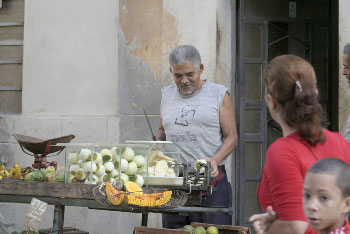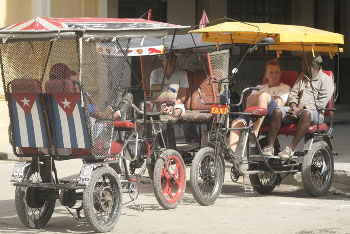Cuba Has Over 400,000 Self-employed

HAVANA TIMES – A total of 429,458 Cubans are registered as self-employed in the 181 activities authorized by the government of Raul Castro since late 2010, according to official statistics.
According to data released by the Ministry of Labor and Social Security, the figure of persons working in the private sector in Cuba was issued at the end of May, which marks an increase of more than 30,000 over last year.
The report notes that self-employment has increased most in the provinces of Havana, Matanzas, Camaguey, Holguin and Santiago de Cuba, which together account for 64 percent of the registered business and new land owners and their laborers.
The largest single group falls in the category of workers hired as labor by private business owners, accounting for 18 percent of all private employment. A total of 83 of the permitted work activities permit the hiring of waged labor.
Slow growth in private sector
In second place are licenses for the preparation and sale of food products, followed by transporters of cargo and passengers; rental housing; street vendors of agricultural products, and producers and sellers of household items.
Nearly 70 percent of the self-employed had no previous employment relationship, and 14 percent were retired, which are not very encouraging indicators for the structural changes and layoffs of government employees projected by Raul Castro.

The government wants to eliminate a million and a half state jobs within five years, assuming the gradual transition to private work forms for those laid off. After almost three years, self-employment covers only a third of the expectations created by the so-called “labor rearrangement”.
The government has sought to stimulate private activity with leasing local barber shops and restaurants, the granting of loans for investment and the provision of state land in usufruct to some 176,000 Cubans.
Illegals under scrutiny
The theme of self-employment and “illegal variants” has become obligatory point in the preparatory meetings of the upcoming Twentieth Congress of the Cuban Labor Federation (CTC) taking place throughout the country.
In a union conference held in Santiago de Cuba last week, representatives of a committee of light food processors-sellers denounced the proliferation of unauthorized vendors, which represent unfair competition for those registered.
“It is easier to be illegal, they pay a fine of 250 pesos if they get caught, while we pay a patent for almost 500 pesos,” said Herminia Casas of Santiago de Cuba.
At the union meeting, Salvador Valdes Mesa, vice president of the State Council, said there is “no reason” for anybody to exercise private activity illegally.






Cuba’s economic disaster will not be resolved with people selling “dura fria” or homemade popsicles to children at a peso apiece. Cuba needs medium-sized or larger privately-owned manufacturing and significant increases in agricultural exports. This level of production will only come after substantial capital infrastructure investment and that is only possible through foreign investment. Until significant foreign investment occurs in Cuba, as took place in Vietnam and China before that, all efforts to reform the ‘self-employment’ sector will have very little impact on Cuba’s current economic freefall.
With Cuba planning to fore about 1 million state workers the fact that nearly none end up as independents is extremely worrying.
From 2010:
“The government’s bet is that it can create enough jobs quickly enough to absorb the laid-off government workers, most of whom it says were not in productive positions. After the first 500,000 jobs are cut, it plans to slash another 500,000 in the next few years, likely leading to more private sector expansion.”
“Key political risks to watch in Cuba | Reuters” http://www.reuters.com/article/2010/12/02/cuba-risks-idUSRISKCU20101202
From the outset it was clear that the first to take advantage of the new opportunities were those that were already in the informal economy and wanted to stabilize their position. Lots of retired people that did continue their job informally took the new status. High taxes stopped lots others. The real “hustlers” from the street trade as the article correctly states.
Of the one million to be fired of the first 500,000 about 200,000 jobs were expected to shift over to employee-run cooperatives that will be created at businesses currently operated by the state. That meant that 300,000 were supposed to shift to private employment.
Data on the cooperatives is sketchy and little data on the true amount of jobs created though Cubans have told that jobs also disappeared from the boated payrolls of some of the new “cooperatives”.
That means that at least 300,000 of the first 500,000 plus those that lost jobs in newly privatized “cooperatives” were expected to find a job for themselves.
Up to now only 68.700 have done so about three years later.
This meas – as the author correctly says – that there is a huge problem for these reforms. Total numbers of people fired will have to be cut leaving the regime with a boated money losing state capitalist system that will drag down the Cuban economy even further.
For the moment the 5 billion in remittances the Cubans receive from abroad keep afloat the people and the regime. Cuba basically relies on the US and the reviled gusanos to survive.
This is another indication that the Castro reforms aren’t working. No real job creation. No real economic progress. It is clear that the regime is unwilling to give more economic and other freedom without which a transition to a working economy can not be done. In the words of Reuters: Raul lost his bet. Time to change plans.
The high profile paladares, bars and pizzerias opened by (ex)members of the political and sports elite are not the solution. The new farmers that are squeezed between the lack of investment, state controls, the lack of wholesale markets both the buy and to sell, the small “fixit” shops that lack parts and equipment, … all are not the solution.
The problem is clear though: the inflexibility of a political elite that wants to remain in power and appropriate wealth for itself.